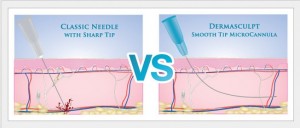Blunt tipped micro-cannulas are newly FDA approved devices used by Plastic Surgeons and other expert injectors to inject popular fillers such as Restylane, Perlane, Juviderm, Belotero, Radiesse and Fat. These devices are similar to the previously used hypodermic needles, but instead have a rounded tip with a side port or a flat tip. Developed by CosmoFrance Inc., DermaSCULPT® needles were recently approved for use and marketing in the United States. Recent studies have shown that patients experience less pain, swelling and bruising with the u se of micro-cannulas compared to the traditional needle. The results of the treatment and longevity were both found to be excellent and safer than traditional techniques.
 Traditional filler injections were, until recently, performed mostly with traditional hypodermic needles supplied by the manufacturers of the most popular products. Patients are either given topical anesthesia, a nerve block, ice/cool air, or no anesthesia depending on the area to be injected. A sharp needle is then introduced through the skin to inject the filler in the desired location and level of the tissues. While the results are excellent, there are disadvantages to this technique including the pain of multiple injections, swelling and bruising caused by the sharp needle injuring the small blood vessels of the face, and the potential for embolization of filler to surrounding blood vessels of the face. “The FDA approval of micro-cannulas has the potential to revolutionize the experience of filler patients everywhere” according to Dr.’s Bitar. “We remain committed to introducing the latest advancements in Aesthetic Surgery in the most ethical manner to improve the experience and outcomes of our patients,” they added.
Traditional filler injections were, until recently, performed mostly with traditional hypodermic needles supplied by the manufacturers of the most popular products. Patients are either given topical anesthesia, a nerve block, ice/cool air, or no anesthesia depending on the area to be injected. A sharp needle is then introduced through the skin to inject the filler in the desired location and level of the tissues. While the results are excellent, there are disadvantages to this technique including the pain of multiple injections, swelling and bruising caused by the sharp needle injuring the small blood vessels of the face, and the potential for embolization of filler to surrounding blood vessels of the face. “The FDA approval of micro-cannulas has the potential to revolutionize the experience of filler patients everywhere” according to Dr.’s Bitar. “We remain committed to introducing the latest advancements in Aesthetic Surgery in the most ethical manner to improve the experience and outcomes of our patients,” they added.
 The new smooth tipped micro-cannula technique differs in several ways compared to the traditional technique. The skin is anesthetized in the usual fashion. A single or double injection port is made in the skin of the affected zone of the face, hands or body with a traditional needle. The smooth tipped cannula is then introduced in an atraumatic way to inject the filler in the desired location. It has several advantages beneficial to patients. Larger areas can be treated from one or two ports without additional sticks. Multiples passes can be safely made in the tissues to improve the aesthetic results.
The new smooth tipped micro-cannula technique differs in several ways compared to the traditional technique. The skin is anesthetized in the usual fashion. A single or double injection port is made in the skin of the affected zone of the face, hands or body with a traditional needle. The smooth tipped cannula is then introduced in an atraumatic way to inject the filler in the desired location. It has several advantages beneficial to patients. Larger areas can be treated from one or two ports without additional sticks. Multiples passes can be safely made in the tissues to improve the aesthetic results.
Less tissue injury results in less bruising and swelling. Because the cannulas are available in multiple lengths and diameters, entire anatomical regions such as lips and naso-labial folds can be treated with a single injection thereby reducing trauma to the tissues. Patients have described the pain of injection as mild compared to the moderate pain experienced with traditional injection techniques. There are other potential advantages of this technique still currently under investigation.
Described as “skin-sculpting” or “derma-sculpting,” there is anecdotal evidence a multi-pass technique at various levels produces a mechanical effect that stimulates more collagen production by fibroblasts in the skin and tissues. The increased deposition of collagen is thought to be the cause of improved longevity and improvement seen with repeated filler injections. This theory has been supported by several well-designed, in-vitro studies looking at bio-mechanical effects on collagen production by fibroblasts. While traditional hypodermic needles will still be necessary for certain applications such as acne scars, traumatic scars and lip lines, blunt tipped micro-cannulas are set to largely replace needles in filler injections. “We are thrilled that our patients are experiencing the benefits of this new technique that will rapidly become the new standard of care”.

George Bitar, MD, FACS is an award-winning, board-certified cosmetic and reconstructive plastic surgeon, the Founder and Medical Director of Bitar Cosmetic Surgery Institute in Virginia. He specializes in the latest surgical and minimally invasive techniques to scar management and reduction. Dr. Bitar is involved in groundbreaking research and education in plastic surgery and has authored numerous articles, abstracts, and chapters.





